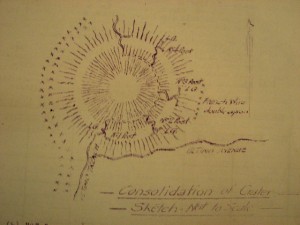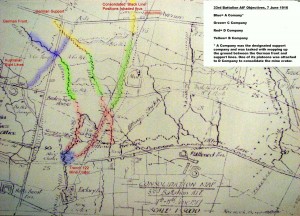An Australian Perspective Thursday, July 19th, 2007
|
|
|
|
|
This is Michael Molkentin here. I am a historian and teacher from Wollongong, Australia; and following Richard’s gracious invitation, will be attending the Ploegsteert excavation.
_
As a historian who has only experienced the Battle of Messines through paper records, I am curious to see how archaeology can contribute to our understanding of the battle. Pouring over the multitude of maps, war diaries and private accounts of the 33rd Battalion’s advance at Trench 122, I have often struggled to visualise things like fields of fire, distances, the impact of flanks etc. These things should become clearer by just walking the ground, but given Flanders apparently (now) featureless geography, getting down into the dirt is probably the only way that we will really be able to appreciate the layout of the battle.
_
From an Australian perspective I also hope that this project will ignite some popular interest in Western Front operations. Here in Australia most people tend to think that Australia’s First World War experience began and ended at Gallipoli in 1915. Where there is some interest, it is usually based on a series of ‘Blackadder’ or Wilfred Owen style stereotypes. For example, when I recently spoke with a well-read ex-school principal about his grandfather who went missing during the Battle of Messines he commented “Tactics in the First World War? What tactics?”. Believe me, after trawling through hundreds of pages of operations orders for the Messines operation there were certainly tactics employed. Major General Monash is reported to have even specified the distinct movements of individual sections in his scheme for the attack!
_
I have attached some results of some of my recent work at the Memorial. Firstly there is a sketch map of the crater that was consolidated by A Company on 7 June 1917. As it was right on the exposed flank of the entire operation it came under heavy fire. Most of the platoon tasked with taking it were killed and it was held throughout the day by seven men. That night, help arrived and established wired posts armed with Lewis guns.
_

_
The second map demonstrates the 33rd Battalion’s objectives for 7 June 1917, all of which it achieved. Remarkably, the black line that the troops managed to dig very closely matched that prescribed in the operation orders before the attack.
_

_
Michael
|
|
|
|
|
|
Filed under: A Dig Diary by
admin
2 Comments »
|
|
Excellent map Michael, my 3 Great uncles were in that battle with the 33rd Battalion, do you have a map showing the Battalion on 23rd July 1917?
Great maps Michael, They really help in understanding the situation facing both sides that day.
Ralph